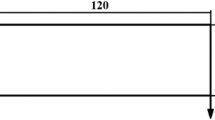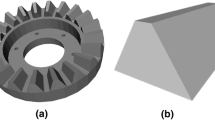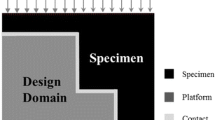Abstract
The amount of supporting structure usage has been a major research topic in layer-based additive manufacturing (AM) over the past years as it leads to increased fabrication time and decreased surface quality. Previous studies focused on deformation and topology optimization to eliminate the number of support structures. However, during the actual fabrication process, the properties of shape and topology are essential. Therefore, they should not be modified casually. In this study, we present an optimizer that reduces the number of supporting structures by identifying the prime printing direction. Without rotation, models are projected in each direction in space, and the basis units involved in the generation of support structures are separated. Furthermore, the area of the supporting structures is calculated. Eventually, the prime printing direction with minimal supporting area is obtained through pattern-searching method. The results of the experiment demonstrated that the printing area was reduced by up to 60% for some cases, and the surface quality was also improved correspondingly. Furthermore, both the material consumption and fabrication time were decreased in most cases. In future work, additional factors will be considered, such as the height of the supporting structures and the adhesion locations to improve the efficiency of this optimizer.







Similar content being viewed by others
References
Cunico MWM (2011) Development of new rapid prototyping process. Rapid Prototyp J 17:138–147
Jin Y, He Y (2014) Optimization of tool-path generation for material extrusion-based additive manufacturing technology. Addit Manuf 1/4:32–47
Pereira S, Vaz AIF, Vicente LN (2018) On the optimal object orientation in additive manufacturing. Int J Adv Manuf Technol 98:1685–1694
Cheng W, Fuh JYH, Nee AYC et al (1995) Multi-objective optimization of part building orientation in stereolithography. Rapid Prototyp J 1(4):12–23
Hu K, Jin S, Wang CCL (2015) Supporting slimming for single material based additive manufacturing. Comput Aided Des 65:1–10
Jiang J, Xu X, Stringer J (2018) Support structures for additive manufacturing: a review. J Manuf Mater Process 2(4):64
Tay YWD, Li MY, Tan MJ (2019) Effect of printing parameters in 3D concrete printing: printing region and support structures. J Mater Process Technol 271:261–270
Gao W (2015) The status, challenges, and future of additive manufacturing in engineering. Comput Aided Des 69:65–89
Stava O, Vanek J, Benes B (2012) Stress relief: improving structural strength of 3D printable objects. ACM Trans Graph 31(4):1–11
Luo L, Baran I, Rusinkiewicz S et al (2012) Chopper: partitioning models into 3D-printable parts. ACM Trans Graph 31(6):1–9
Chen D, Levin D, Didyk P et al (2013) Spec2Fab: a reducer-tuner model for translating specifi cations to 3D prints. ACM Trans Graph 32(4):1–9
Paul R, Anand S (2015) Optimization of layered manufacturing process for reducing form errors with minimal support structures. J Manuf Syst 35:231–243
Leary M, Merli L, Torti F et al (2014) Optimal topology for additive manufacture: a method for enabling additive manufacture of support-free optimal structures. Mater Des 63:678–690
Prévost R, Whiting E, Lefebvre S et al (2013) Make it stand: balancing shapes for 3D fabrication. ACM Trans Graph 32(4):1–10
Wang W, Wang TY, Yang Z et al (2013) Cost-effective printing of 3D objects with skin-frame structures. ACM Trans Graph 32(6):1–10
Chen Y (1997) Determining parting direction based on minimum bounding box and fuzzy logics. Int J Mach Tools Manuf 37(9):1189–1199
Priyadarshi AK, Gupta SK (2006) Finding mold-piece regions using computer graphics hardware. Lect Notes Comput Sci 4077:655–662
Khardekar R, Burton G, McMains S (2006) Finding feasible mold parting directions using graphics hardware. Comput Aided Des 38(4):327–341
Li W, Martin R, Langbein FC (2009) Molds for meshes: computing smooth parting lines and undercut removal. IEEE Trans Autom Sci Eng 6(3):423–432
Cheng B, Chou K (2015) Geometric consideration of support structures in part overhang fabrications by electron beam additive manufacturing. Comput Aided Des 69:102–111
Giannitelli SM, Mozetic P, Trombetta M et al (2015) Combined additive manufacturing approaches in tissue engineering. Acta Biomater 24:1–11
Tyberg J, Bohn JH (1999) FDM systems and local adaptive slicing. Mater Des 20(2/3):77–82
Huang P, Wang CCL, Chen Y (2014) Algorithms for layered manufacturing in image space. Adv Comput Inf Eng Res 1:377–410
Chen Y, Li K, Qian X (2013) Direct geometry processing for tele-fabrication. J Comput Inf Sci Eng 13(4):1–18
Acknowledgements
This work was supported from the National Key R&D Program of China (Grant No. 2017YFB1104100), the National Natural Science Foundation of China (Grant Nos. 81971709, 81828003), the Foundation of Ministry of Education of China Science and Technology Development Center (Grant No. 2018C01038), the Foundation of Science and Technology Commission of Shanghai Municipality (Grant Nos. 19510712200, 16441908400), and Shanghai Jiao Tong University Foundation on Medical and Technological Joint Science Research (Grant Nos. YG2016ZD01, ZH2018ZDA15).
Author information
Authors and Affiliations
Corresponding author
Rights and permissions
About this article
Cite this article
Chen, XJ., Hu, JL., Zhou, QL. et al. An automatic optimization method for minimizing supporting structures in additive manufacturing. Adv. Manuf. 8, 49–58 (2020). https://doi.org/10.1007/s40436-019-00277-y
Received:
Revised:
Accepted:
Published:
Issue Date:
DOI: https://doi.org/10.1007/s40436-019-00277-y




